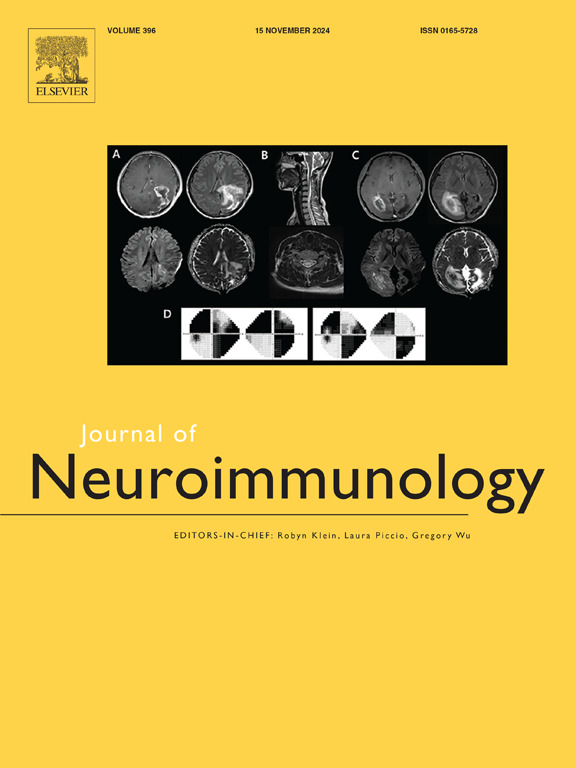Salidroside attenuates cognitive deficits induced by chronic cerebral hypoperfusion via modulating microglial phenotypic transformation in mice
IF 2.9
4区 医学
Q3 IMMUNOLOGY
引用次数: 0
Abstract
Background
Chronic cerebral hypoperfusion (CCH) is a significant contributor to vascular cognitive impairment (VCI), often linked to cortical and hippocampal damage. This study investigates the therapeutic potential of salidroside (SLDS) in mitigating CCH-induced brain injury by modulating microglial activation and inflammatory responses.
Methods
We established a CCH model in mice using the 0.16/0.18 mm bilateral common carotid artery stenosis (BCAS) procedure. We assessed cerebral blood flow (CBF) via laser speckle contrast imaging, while neuropathology was evaluated through Nissl staining and immunofluorescence (IF) experiments. Cognitive deficits were measured using the Morris water maze test. Neuronal apoptosis and neuroinflammation were examined through IF, ELISA, and qRT-PCR.
Results
BCAS-induced hypoperfusion resulted in a marked reduction in CBF, increased neuronal apoptosis, and significant cognitive deficits. SLDS treatment effectively countered these effects by shifting microglial polarization from a pro-inflammatory M1 phenotype to an anti-inflammatory M2 phenotype, reducing pro-inflammatory cytokine levels, and enhancing neuronal survival.
Conclusion
SLDS demonstrates strong neuroprotective potential against CCH-induced brain injury by reducing inflammation and preventing neuronal apoptosis. These findings highlight the promise of SLDS as a therapeutic agent for chronic cerebrovascular disorders, warranting further investigation into its molecular mechanisms and clinical applicability.
红景天苷通过调节小鼠小胶质细胞表型转化减轻慢性脑灌注不足引起的认知缺陷
背景:慢性脑灌注不足(CCH)是血管性认知障碍(VCI)的重要因素,通常与皮质和海马损伤有关。本研究探讨了红景天苷(SLDS)通过调节小胶质细胞激活和炎症反应来减轻cch诱导的脑损伤的治疗潜力。方法采用0.16/0.18 mm双侧颈总动脉狭窄(BCAS)法建立小鼠颈总动脉狭窄模型。我们通过激光散斑造影评估脑血流量(CBF),同时通过尼氏染色和免疫荧光(IF)实验评估神经病理学。认知缺陷用莫里斯水迷宫测试来测量。采用IF、ELISA和qRT-PCR检测神经元凋亡和神经炎症。结果bcas诱导的低灌注导致CBF明显减少,神经元凋亡增加,认知功能明显受损。SLDS治疗通过将小胶质细胞极化从促炎M1表型转变为抗炎M2表型,降低促炎细胞因子水平,提高神经元存活率,有效地抵消了这些影响。结论slds对cch所致脑损伤具有较强的神经保护作用,可减轻炎症反应,防止神经元凋亡。这些发现突出了SLDS作为慢性脑血管疾病治疗剂的前景,值得进一步研究其分子机制和临床适用性。
本文章由计算机程序翻译,如有差异,请以英文原文为准。
求助全文
约1分钟内获得全文
求助全文
来源期刊

Journal of neuroimmunology
医学-免疫学
CiteScore
6.10
自引率
3.00%
发文量
154
审稿时长
37 days
期刊介绍:
The Journal of Neuroimmunology affords a forum for the publication of works applying immunologic methodology to the furtherance of the neurological sciences. Studies on all branches of the neurosciences, particularly fundamental and applied neurobiology, neurology, neuropathology, neurochemistry, neurovirology, neuroendocrinology, neuromuscular research, neuropharmacology and psychology, which involve either immunologic methodology (e.g. immunocytochemistry) or fundamental immunology (e.g. antibody and lymphocyte assays), are considered for publication.
文献相关原料
公司名称
产品信息
阿拉丁
SLDS
 求助内容:
求助内容: 应助结果提醒方式:
应助结果提醒方式:


